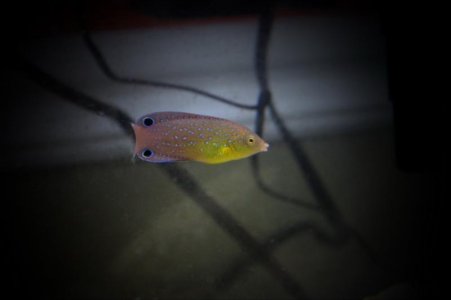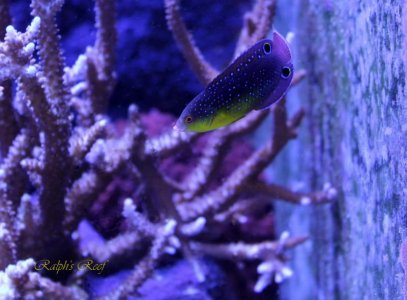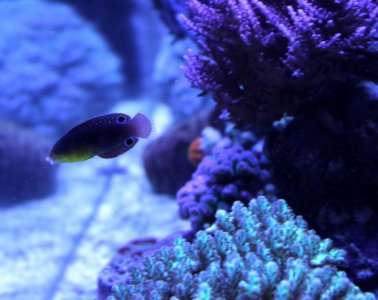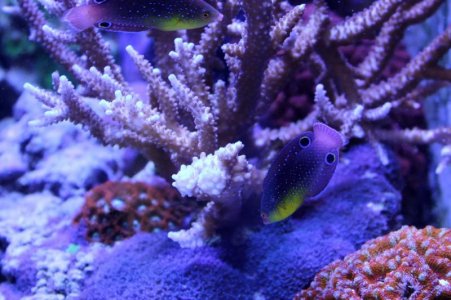You are using an out of date browser. It may not display this or other websites correctly.
You should upgrade or use an alternative browser.
You should upgrade or use an alternative browser.
Tamarin Wrasse Primer.
- Thread starter Western_reefer
- Start date
iamwrasseman
New member
just be careful with the yellow tail as they really are not reef safe . I have had a few and most never nipped at anything coral wise but I did get one that was about 5" and he was devastating to my corals . I had to pull him out within a couple of days as he went wild on my LPS corals so just keep an eye on him . many times it depends on what they have learned in the wild and bring to your home . also if he does get destructive all your other wrasses will quickly learn from him and it can be very chaotic to say the least . Beautiful fish there and thanks for sharing !
HiImSean
Member
I'm hoping you guys can give a little more experiences with A. neoguinaicus. A LFS near by has one and said they can get more in. I'm passing for now since I'm going to be traveling a couple times in the next few weeks for work. Theirs is about 3", nice and fat, and supposedly eating well. Would it be better to get a larger one or try ordering some smaller ones from LA? I know they don't ship well so I would imagine getting my LFS to get it would be more ideal. Their 3" is $80 while LA has been having them regularly for $30.
Also is LA correct about their size, getting to 9"? From the few threads/posts I've seen about them it seems like they don't get that large.
Also is LA correct about their size, getting to 9"? From the few threads/posts I've seen about them it seems like they don't get that large.
iamwrasseman
New member
I have a couple at the store right now that are doing great but pleases do be aware of that $80 price tag as that's really up there IME. your LFS probably gets them from LA anyway so I would get them from dr. fosters and smith or blue zoo as they both have a good warranty you may have to start them on live brine like many of the wrasses but I have mine eating pellets already after just a week and a half.
best wishes
best wishes
Ralph ATL
Formerly mysterybox
I'm hoping you guys can give a little more experiences with A. neoguinaicus. A LFS near by has one and said they can get more in. I'm passing for now since I'm going to be traveling a couple times in the next few weeks for work. Theirs is about 3", nice and fat, and supposedly eating well. Would it be better to get a larger one or try ordering some smaller ones from LA? I know they don't ship well so I would imagine getting my LFS to get it would be more ideal. Their 3" is $80 while LA has been having them regularly for $30.
Also is LA correct about their size, getting to 9"? From the few threads/posts I've seen about them it seems like they don't get that large.
don't leave that lfs with the fish until you see it eat...I would put it in a QT system like I had my Yellow Breasted...for 2-4 weeks (with some fine sand and a pvc pipe...powerhead, etc...
THE PAIR in display tank!
Attachments
Last edited:
iamwrasseman
New member
THIS IS WHAT I HAVE FOUND OUT THROUGH 35+ YEARS WITH LEOPARD WRASSES AND QT VS DT's..........Although QT do have there place in our hobby ,most leopard and tamarin wrasses do not fair out very well in a QT . You will have close to an 80% to 90% survival rate if you introduce them directly into your DT . If you put them into a QT your survival rate will be much lower like 20% unless your QT is decorated much like your DT .You will need live rock , live sand 2"-3" deep and the QT will need to be pre cycled in order for a better survival rate . if you spatter some live sand and a couple of PVC pieces about then you will be down around the 20% survival rate as above mentioned .if you decorate ,cycle , and have live rock in your QT then you will be in the 70% range .
Ralph ATL
Formerly mysterybox
THIS IS WHAT I HAVE FOUND OUT THROUGH 35+ YEARS WITH LEOPARD WRASSES AND QT VS DT's..........Although QT do have there place in our hobby ,most leopard and tamarin wrasses do not fair out very well in a QT . You will have close to an 80% to 90% survival rate if you introduce them directly into your DT . If you put them into a QT your survival rate will be much lower like 20% unless your QT is decorated much like your DT .You will need live rock , live sand 2"-3" deep and the QT will need to be pre cycled in order for a better survival rate . if you spatter some live sand and a couple of PVC pieces about then you will be down around the 20% survival rate as above mentioned .if you decorate ,cycle , and have live rock in your QT then you will be in the 70% range .
This is where we now disagree. I listened to your advice about no Qt...Successful, but not % high enough...Lost too many fish..
60-80%
QT success is 100%
It's amazing because they have no competitors so you can insure that they eat and you can feed them 12-14 times a day...I was instructed by Kevin at LiveAquaria on these methods, and I use them 100% of the time...
Straight in the display I once believed to be correct from this thread, is a no, no!
I mean you have this little Anampses or Leopard in a 10 Gallon (Pre-set up with Seachem Matrix), and 2 pounds of sugar fine sand feeding 10-14 times a day with a mini powerhead? HOW COULD YOU GO WRONG? you have all observations and control except if the fish would eat or not....
MIKE NY
Two Decade club
I have the best results with a acclimation tank which contains plenty of LR for which they can pick off from untill they start taking prepared foods and fine sand for them to sleep and hide...once they appear to be healthy and aggressively eating then I place them in the DT where they are strong enough to compete for food..I place them in a small plastic accliamtion box in the DT in the morning to check for any aggression and they are in just before lights out that same day...
iamwrasseman
New member
Hey Ralph, I do in many ways agree ways with what you are doing and fully understand that there are many ways to accomplish the same point. I also agree that we do disagree and we each have had good results acclimating wrasses in two totally different ways . mine does work for me and may have resulted from knowledge that I have gained in the past twenty years but it still to this day works for me .I can fully agree that your way of acclimation is very good and the one thing that I cannot get past is that there is something forgotten many times and that's the stress put on the fish ,I may have left something out not on purpose but I don't always put my wrasses into their final DT but rather a tank with a small amount of successfully acclimated wrasses along with my "newbie" and that may have confused you as to my angle rather than a barren tank which I also think you have some "reeflike" settings but I may be mistaken. right now I have a few leopards in my coral tanks and that is where I first place and acclimate my new wrasses . not all are done this way but I do it with all my leopards and it works for me very well.
I am sorry if you think I have mislead you in this acclimation process and also would listen to anything that kevin has instructed you to do as he has a super laboratory to do this in and is one of the best at what he does along with his huge knowledge for many specific fish that you or I may lump into groups or at least I would .I don't want to put words into your mouth so I can speak for myself as i am still learning every time I do this and please believe me I do pay tons of attention each and every time I acclimate these fish that are really better off left on the reef. when they "harvest"1000 leopard wrasses from an area you have to admit that in there hearts they know only a few will make it past six months and most will not even make it into the states .I wish there was more well defined information on this process but we both are having much more success than the average reef keeper and I do respect you opinion along with your process ! I do mean this from the bottom of my heart. your opinion means more than you can possibly know to me as we need to always remember that this is a very difficult process that we both are trying to figure out . One thing that we have not been able to communicate upon is also a huge " KEY" to this whole puzzle is the source of our fish concerned and that can make a huge difference . I will pm you so maybe we can shed some light on our source for these concerned fish buddy
I also wish you all the luck in the world and hope that you still have as much fun as i do with these beautiful creatures .
thanks Dave
I am sorry if you think I have mislead you in this acclimation process and also would listen to anything that kevin has instructed you to do as he has a super laboratory to do this in and is one of the best at what he does along with his huge knowledge for many specific fish that you or I may lump into groups or at least I would .I don't want to put words into your mouth so I can speak for myself as i am still learning every time I do this and please believe me I do pay tons of attention each and every time I acclimate these fish that are really better off left on the reef. when they "harvest"1000 leopard wrasses from an area you have to admit that in there hearts they know only a few will make it past six months and most will not even make it into the states .I wish there was more well defined information on this process but we both are having much more success than the average reef keeper and I do respect you opinion along with your process ! I do mean this from the bottom of my heart. your opinion means more than you can possibly know to me as we need to always remember that this is a very difficult process that we both are trying to figure out . One thing that we have not been able to communicate upon is also a huge " KEY" to this whole puzzle is the source of our fish concerned and that can make a huge difference . I will pm you so maybe we can shed some light on our source for these concerned fish buddy
I also wish you all the luck in the world and hope that you still have as much fun as i do with these beautiful creatures .
thanks Dave
Last edited:
Ralph ATL
Formerly mysterybox
Hey Ralph, I do in many ways agree ways with what you are doing and fully understand that there are many ways to accomplish the same point. I also agree that we do disagree and we each have had good results acclimating wrasses in two totally different ways . mine does work for me and may have resulted from knowledge that I have gained in the past twenty years but it still to this day works for me .I can fully agree that your way of acclimation is very good and the one thing that I cannot get past is that there is something forgotten many times and that's the stress put on the fish ,I may have left something out not on purpose but I don't always put my wrasses into their final DT but rather a tank with a small amount of successfully acclimated wrasses along with my "newbie" and that may have confused you as to my angle rather than a barren tank which I also think you have some "reeflike" settings but I may be mistaken. right now I have a few leopards in my coral tanks and that is where I first place and acclimate my new wrasses . not all are done this way but I do it with all my leopards and it works for me very well.
I am sorry if you think I have mislead you in this acclimation process and also would listen to anything that kevin has instructed you to do as he has a super laboratory to do this in and is one of the best at what he does along with his huge knowledge for many specific fish that you or I may lump into groups or at least I would .I don't want to put words into your mouth so I can speak for myself as i am still learning every time I do this and please believe me I do pay tons of attention each and every time I acclimate these fish that are really better off left on the reef. when they "harvest"1000 leopard wrasses from an area you have to admit that in there hearts they know only a few will make it past six months and most will not even make it into the states .I wish there was more well defined information on this process but we both are having much more success than the average reef keeper and I do respect you opinion along with your process ! I do mean this from the bottom of my heart. your opinion means more than you can possibly know to me as we need to always remember that this is a very difficult process that we both are trying to figure out . One thing that we have not been able to communicate upon is also a huge " KEY" to this whole puzzle is the source of our fish concerned and that can make a huge difference . I will pm you so maybe we can shed some light on our source for these concerned fish buddy
I also wish you all the luck in the world and hope that you still have as much fun as i do with these beautiful creatures .
thanks Dave
my apologies, I just reread my post, and I did not "come across" as intended. Maybe even a little condescending, as I was typing on my iphone while watching something at the same time!
Yes, we do not agree here.
Yes, there are different ways to do things.
Yes, I have utmost respect for you and your knowledge that you share with Leopards & Tamarins.
We are all good!
I've had good luck QTing lots of tough wrasses with copper, prazi, antibiotics, and freshwater dips. Leopards, anampses, pseudojuloides, cirrhilabrus, halichoeres, scarus, etc. It can be done. You may need to feed more often than in a well established display, and it has to be cycled. But I have found relatively simple setups work well. Sandy bottom, and lots of food are key.
aquaph8
Love The Fish
No offense to Dave or anybody else but I honestly feel anybody that still refers to QT as the "stressful option" and blames that on why they don't do it has some learning to do. It is a learning process all it's self and takes some trial and error and is in many ways challenging but in the long run QT makes you such a better reefer. The process puts so many things back in your contol from feeding, lighting and with these guys even their sleep cycle. Beats sitting around wondering if they're gonna come out of the sand and wondering if they're eating. I urge everyone to give it a shot.
CedzAquAddictio
New member
Most of the time I run my QT 24/7/365. With easier fish, I just use PVC. With sensitive fish like the leopard wrasses, I use LR that is dedicated to my QT only. It stays cycled and may contain medication, so it never sees my DT. I premix my water with medication in batches and do the best I can with keeping my medication levels on par since the rock may absorb or leach it into the water.
Marshall O
New member
No offense to Dave or anybody else but I honestly feel anybody that still refers to QT as the "stressful option" and blames that on why they don't do it has some learning to do. It is a learning process all it's self and takes some trial and error and is in many ways challenging but in the long run QT makes you such a better reefer. The process puts so many things back in your contol from feeding, lighting and with these guys even their sleep cycle. Beats sitting around wondering if they're gonna come out of the sand and wondering if they're eating. I urge everyone to give it a shot.
I agree 100%, though I am still a "newbie". Took 9 days, but I finally got my M. bipartitus on EST in my 46 QT (that has sand and live rock). Tank has been setup for almost to years, so plenty of pods for it to hunt. Gets fed 2-3 times a day otherwise. Can't imagine just throwing it into my DT with the established Tangs & Wrasses and hope for the best :/
purebullet417
Rimless Reef Club
So these yellow tails aren't reef safe? According to one person but most of you seem to have them. Would one be ok in a 57
MIKE NY
Two Decade club
mine is...got it as a LFS resecue and now is over 5". It chased a newly added Blue potted tamarin for about a day, but it was fine the next and doesn't bother anything...I feed mutliple times a day which probably helps. Should be fine in a 57 short term with the right docile tankmates because they do grow to 8.5 -9".
iamwrasseman
New member
No offense taken by anyone in any way as we are exchanging information in an attempt to better this hobby and there are many ways of doing everything . I am only expressing what I have had best results with .
There is a huge difference in survival rate in my "selling display" tanks with leopard wrasses VS. putting them in my coral tanks where there are plenty of pods and a more "realistic" setting free of other "bothersome" fish and I will only introduce them into my coral tanks and boy is it tough to catch them when I sell them .It's usually a half hour of removing the live rock and most of the corals in order to catch them but it works very well.I usually purchase three or more at a time and they have all acclimated very well .
On another note at my house as you all know I do directly put them into my DT and have very good results without introducing and disease but it could happen for sure .
In a QT with proper décor and sand yes it is a much better place to observe and treat for any disease or parasites for sure .At home I had horrible results in QT and just found that everything went much better in my DT with a prazi pro treatment .I never have had to treat for any other disease etc and have had great results that way and that's why I preach this manner of "acclimation" as an observation from my experience's .
sorry if I offended anyone as I have somewhat stated that there is only one way but I do know that there are many ways and many of them are great ways to accomplish the same result .
Happy reefing to ya all !
There is a huge difference in survival rate in my "selling display" tanks with leopard wrasses VS. putting them in my coral tanks where there are plenty of pods and a more "realistic" setting free of other "bothersome" fish and I will only introduce them into my coral tanks and boy is it tough to catch them when I sell them .It's usually a half hour of removing the live rock and most of the corals in order to catch them but it works very well.I usually purchase three or more at a time and they have all acclimated very well .
On another note at my house as you all know I do directly put them into my DT and have very good results without introducing and disease but it could happen for sure .
In a QT with proper décor and sand yes it is a much better place to observe and treat for any disease or parasites for sure .At home I had horrible results in QT and just found that everything went much better in my DT with a prazi pro treatment .I never have had to treat for any other disease etc and have had great results that way and that's why I preach this manner of "acclimation" as an observation from my experience's .
sorry if I offended anyone as I have somewhat stated that there is only one way but I do know that there are many ways and many of them are great ways to accomplish the same result .
Happy reefing to ya all !
dotcommer
Active member
I have a spotted wrasse in QT right now and he is doing great. One thing I feel has added to the success is my Algae Turf Scrubber. I have two on my main display that grow pods and amphipods like crazy. When I clean the scrubber there are thousands in the algae that are arvested. When I purchased the wrasses I harvested some algae and put it into a container with sand. I slowly lowered the container into my QT tank and the wrasse immediately went crazy picking at the algae with the pods. I also added some white filter padding in my algae scrubber and in my sump. The filter pads are great for getting pods to attach to them. I have been swapping these filter pads out every other which the wrasse goes crazy for when i put them in. I am also feeding live brine which he loves as well.
Similar threads
- Poll
- Replies
- 17
- Views
- 2K
- Replies
- 1
- Views
- 2K




